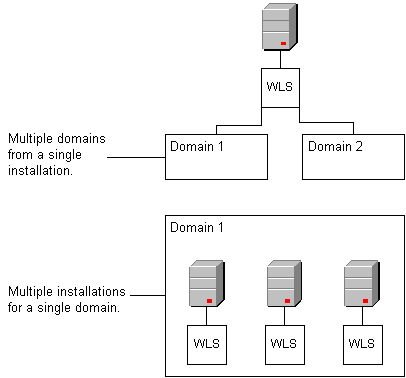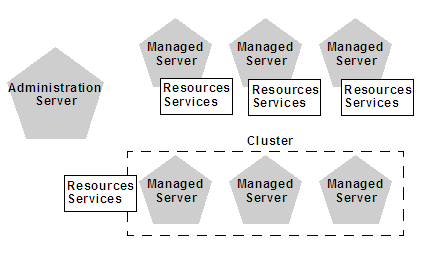What Is a Domain?
An Oracle WebLogic Server administration domain is a logically related group of Oracle WebLogic Server resources.
Domains include a special Oracle WebLogic Server instance called the Administration Server, which is the central point from which you configure and manage all resources in the domain.
Usually, you configure a domain to include additional Oracle WebLogic Server instances called Managed Servers.
You deploy Web applications, EJBs, Web Services, and other resources onto the Managed Servers and use the Administration Server for configuration and management purposes only.
Organizing Domains
You can use a single Oracle WebLogic Server installation to create and run multiple domains, or you can use multiple installations to run a single domain

How you organize your Oracle WebLogic Server installations into domains depends on your business needs. You can define multiple domains based on different system administrators' responsibilities, application boundaries, or geographical locations of the machines on which servers run. Conversely, you might decide to use a single domain to centralize all Oracle WebLogic Server administration activities.
Depending on your particular business needs and system administration practices, you might decide to organize your domains based on criteria such as:
- Logical divisions of applications. For example, you might have one domain devoted to end-user functions such as shopping carts and another domain devoted to back-end accounting applications.
- Physical location. You might establish separate domains for different locations or branches of your business. Each physical location requires its own Oracle WebLogic Server installation.
- Size. You might find that domains organized in small units can be managed more efficiently, perhaps by different system administrators. Contrarily, you might find that maintaining a single domain or a small number of domains makes it easier to maintain a consistent configuration.
For development or test environments, you can create a simple domain that consists of a single server instance.
This single instance acts as an Administration Server and hosts the applications that you are developing.
The wl_server domain that you can install with Oracle WebLogic Server is an example of this type of domain.
Contents of a Domain
A production environment that contains an Administration Server, three stand-alone Managed Servers, and a cluster of three Managed Servers.
Administration Server:
The Administration Server operates as the central control entity for the configuration of the entire domain. It maintains the domain's configuration documents and distributes changes in the configuration documents to Managed Servers. You can also use the Administration Server as a central location from which to monitor all resources in a domain.To interact with the Administration Server, you can use the Administration Console.Each Oracle WebLogic Server domain must have one server instance that acts as the Administration Server.
What Happens if the Administration Server Fails?
The failure of an Administration Server does not affect the operation of Managed Servers in the domain but it does prevent you from changing the domain's configuration.
If an Administration Server fails because of a hardware or software failure on its host machine, other server instances on the same machine may be similarly affected.
However, the failure of an Administration Server itself does not interrupt the operation of Managed Servers in the domain.
If an Administration Server for a domain becomes unavailable while the server instances it manages—clustered or otherwise—are up and running, those Managed Servers continue to run.
Periodically, the Managed Servers attempt to reconnect to the Administration Server.
If the domain contains clustered server instances, the load balancing and failover capabilities supported by the domain configuration remain available, even if the Administration Server fails
You can start a Managed Server even if the Administration Server is not running.
In this case, the Managed Server uses a local copy of the domain's configuration files for its starting configuration and then periodically attempts to connect with the Administration Server.
When it does connect, it synchronizes its configuration state with that of the Administration Server.
Information on Restarting Administration server
here
Managed Servers and Managed Server Clusters
Managed Servers host business applications, application components, Web Services, and their associated resources.
To optimize performance, Managed Servers maintain a read-only copy of the domain's configuration document.
When a Managed Server starts up, it connects to the domain's Administration Server to synchronize its configuration document with the document that the Administration Server maintains.
For production environments that require increased application performance, throughput, or high availability, you can configure two or more Managed Servers to operate as a cluster.
A cluster is a collection of multiple Oracle WebLogic Server instances running simultaneously and working together to provide increased scalability and reliability.
In a cluster, most resources and services are deployed identically to each Managed Server (as opposed to a single Managed Server), enabling failover and load balancing.
A single domain can contain multiple Oracle WebLogic Server clusters, as well as multiple Managed Servers that are not configured as clusters.
The key difference between clustered and non-clustered Managed Servers is support for failover and load balancing. These features are available only in a cluster of Managed Servers
Domain Restrictions
In designing your domain configuration, note the following restrictions:
- Each domain requires its own Administration Server for performing management activities. When you use the Administration Console to perform management and monitoring tasks, you can switch back and forth between domains, but in doing so, you are connecting to different Administration Servers.
- All Managed Servers in a cluster must reside in the same domain; you cannot split a cluster over multiple domains.
- All Managed Servers in a domain must run the same version of the Oracle WebLogic Server software. The Administration Server may run either the same version as the Managed Servers in the domain, or a later service pack.
If you have created multiple domains, each domain must reference its own database schema. You cannot share a configured resource or subsystem between domains. For example, if you create a JDBC data source in one domain, you cannot use it with a Managed Server or cluster in another domain. Instead, you must create a similar data source in the second domain. Furthermore, two or more system resources cannot have the same name.
Cheers,



0 comments:
Post a Comment